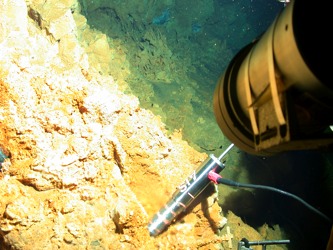FeMO2 Dive Cruise 2007
Report -- An Opportunity to Link Chemistry and Microbiology at Marker 39
FeMO2 Dive Cruise 2007 |

I have been lucky enough to participate in PISCES manned-submersible dives in Pele's pit in previous years with the Hawaii Undersea Research Lab team on the Kilo Moana's sister ship, the KOK (as have many of us currently onboard). But yesterday's dive with JASON 2 into Pele's pit was just as exciting as any of those previous experiences. The highlight for me was Marker 39, on the eastern wall of the crater. This is a site that I have never visited before, but it is a clear favorite of our chief Scientist Craig Moyer. At Marker 39 we can find the hottest hydrothermal fluids currently venting into Pele's Pit.

This year the maximum temperature recorded was 53 celsius - a really nice hot bath, but significantly cooler than observed up to 10 years ago. Hot fluids can be seen shimmering out of numerous fractures and small holes that pocket the rock outcrop, and abundant microbial mats are waving back and forth in the venting fluids. At this site, although the majority of mat material is stained orange with iron oxides, you can also observe white streamers with sulfur minerals. It turns out that the fluid chemistry, and fluid mixing patterns, is quite dynamic over small spatial scales here. Using the ISEA, we probed the temperature, oxygen, iron and sulfide concentrations in numerous holes and found that each parameter fluctuated widely from hole to hole. On the right side of the Marker 39 area, huge spikes in sulfide were observed, whereas fluids tested on the left side showed less sulfide and more Fe. The temperatures were hottest in the high sulfide areas.
All of the detailed chemical data will need to be carefully analyzed to determine the fluid hydrology, but what is clear at M39 is that in one small area you can observe a snapshot of how dynamic the entire Pit area can be. Essentially there are Fe-rich areas, sulfide-rich areas, hot fluids, cold fluids, and visible differences in the structure of the microbial mats, raising the question: how do the microbial communities vary across these dramatic gradients? Looks like this is an excellent place to explore fundamental questions about how the chemistry of this system defines who (microbiologically) is present and active.
| FeMO2 Cruise Home Page |